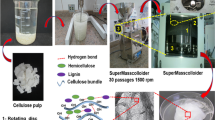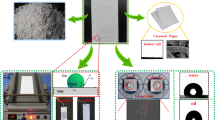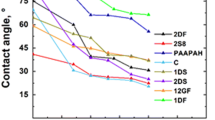Abstract
Supercritical impregnation may be used to impart specific functional properties into porous substrates such as wood, textiles, or paper. In the current study, food-grade beeswax (BW), carnauba wax (CW) and vegetable wax (VW) were impregnated into paper substrates to improve their hydrophobicity and mechanical strength. The contact angle of impregnated and annealed samples was approximately 110–120° when annealed at 140 °C, and 130° when annealed at 160 °C. SEM analyses revealed that dual micro- and nano-scale roughness was generated in impregnated paper substrates that also underwent annealing. FTIR analysis showed evidence of H-bonding between the waxes and cellulose, but this was more dominant with BW/CW compared with VW due to the different chemical structures of the waxes. Annealed samples showed lower intensity FTIR peaks, tentatively confirming a phase transition of the waxes as a result of the annealing. A reduced tan delta signal up to the secondary alpha transition temperature for paper was observed with BW/CW impregnated samples, indicating the formation of additional chemical bonds between cellulose and wax. Compared with untreated paper substrates, the sharp decrease in storage modulus during degradation occurred at temperatures up to 10 °C higher for wax-impregnated papers, and up to 40 °C lower for baseline papers impregnated and annealed without wax. It is believed that the H-bonds between the waxes and cellulose were able to withstand higher temperatures in the degradation region, thus offsetting the effects of sample preparation.





Similar content being viewed by others
Availability of data and material
All experimental data will be made available upon request to the corresponding author.
References
Abdikheibari S, Parvizi R, Moayed M et al (2015) Beeswax-colophony blend: a novel green organic coating for protection of steel drinking water storage tanks. Metals 5:1645–1664. https://doi.org/10.3390/met5031645
Adenekan K (2019) Hydrophobization of cellulose-based fibers for packaging applications with alkyl ketene dimers (AKD) and food-grade waxes via supercritical impregnation with carbon dioxide: experimental and thermodynamic modeling approaches. Ph.D. dissertation, University of Mississippi
Adenekan K, Hutton-Prager B (2019) Sticky hydrophobic behavior of cellulose substrates impregnated with alkyl ketene dimer (AKD) via sub- and supercritical carbon dioxide. Colloids Surf Physicochem Eng Asp 560:154–163. https://doi.org/10.1016/j.colsurfa.2018.09.073
Buchwald R, Breed MD, Greenberg AR (2008) The thermal properties of beeswaxes: unexpected findings. J Exp Biol 211:121–127. https://doi.org/10.1242/jeb.007583
Chen S, Song Y, Xu F (2018) Highly transparent and hazy cellulose nanopaper simultaneously with a self-cleaning superhydrophobic surface. ACS Sustain Chem Eng 6:5173–5181. https://doi.org/10.1021/acssuschemeng.7b04814
Chick J, Hernandez RJ (2002) Physical, thermal, and barrier characterization of casein-wax-based edible films. J Food Sci 67:1073–1079. https://doi.org/10.1111/j.1365-2621.2002.tb09455.x
Del Curto B, Barelli N, Profaizer M et al (2016) Poly-paper: a sustainable material for packaging, based on recycled paper and recyclable with paper. J Appl Biomater Funct Mater. https://doi.org/10.5301/jabfm.5000335
Dunn AS (1994) Introduction to physical polymer science (2nd edition). By L. H. Sperling, New York, 1992 John Wiley & Sons Inc. John Wiley & Sons Inc., New York, 1992. pp. xxvii + 594, price £55.00. ISBN 0-471-53035-2. Polym Int 33:233–233. https://doi.org/10.1002/pi.1994.210330214
Fei T, Wang T (2017) A review of recent development of sustainable waxes derived from vegetable oils. Curr Opin Food Sci 16:7–14. https://doi.org/10.1016/j.cofs.2017.06.006
Gaillard Y, Mija A, Burr A et al (2011) Green material composites from renewable resources: Polymorphic transitions and phase diagram of beeswax/rosin resin. Thermochim Acta 521:90–97. https://doi.org/10.1016/j.tca.2011.04.010
Galvão JG, Santos RL, Lira AAM et al (2020) Stearic acid, beeswax and carnauba wax as green raw materials for the loading of carvacrol into nanostructured lipid carriers. Appl Sci 10:6267. https://doi.org/10.3390/app10186267
Girardi F, Maggini S, Della Volpe C et al (2011) Hybrid organic–inorganic materials on paper: surface and thermo-mechanical properties. J Sol-Gel Sci Technol 60:315–323. https://doi.org/10.1007/s10971-011-2563-z
Gonjo T, Futami Y, Morisawa Y et al (2011) Hydrogen bonding effects on the wavenumbers and absorption intensities of the oh fundamental and the first, second, and third overtones of phenol and 2,6-dihalogenated phenols studied by visible/near-infrared/infrared spectroscopy. J Phys Chem A 115:9845–9853. https://doi.org/10.1021/jp201733n
Hagenmaier RD, Baker RA (1997) Edible coatings from morpholine-free wax microemulsions. J Agric Food Chem 45:349–352. https://doi.org/10.1021/jf9604551
He M, Cho B-U, Won JM (2016) Effect of precipitated calcium carbonate—Cellulose nanofibrils composite filler on paper properties. Carbohydr Polym 136:820–825. https://doi.org/10.1016/j.carbpol.2015.09.069
Ioelovich M (2016) Isophase transitions of cellulose: a short review. Athens J Sci 3:309–322. https://doi.org/10.30958/ajs.3-4-4
Iselau F, Malmborg-Nystrm K, Holmberg K, Bordes R (2018) Parameters influencing hydrophobization of paper by surface sizing. Nord Pulp Pap Res J 33:95–104. https://doi.org/10.1515/npprj-2018-3015
Kameda T (2004) Molecular structure of crude beeswax studied by solid-state 13C NMR. J Insect Sci. https://doi.org/10.1093/jis/4.1.29
Lavoratti A, Scienza LC, Zattera AJ (2016) Dynamic-mechanical and thermomechanical properties of cellulose nanofiber/polyester resin composites. Carbohydr Polym 136:955–963. https://doi.org/10.1016/j.carbpol.2015.10.008
Li P, Li H, Yang J, Meng Y (2016) Facile fabrication of superhydrophobic paper with excellent water repellency and moisture resistance by phase separation. BioResources 11:6552–6565
Li Y, Qian J, Wang Z et al (2020) Effect of beeswax impregnation on the dimensional stability, surface properties, and thermal characteristics of wood. BioResources 15:2181–2194
Mallamace F, Corsaro C, Mallamace D et al (2015) Water and lysozyme: some results from the bending and stretching vibrational modes. Front Phys. https://doi.org/10.1007/s11467-015-0488-7
McMurry J (2012) Organic chemistry. Brooks/Cole Cengage Learning, Singapore
Mohanan A, Bouzidi L, Narine SS (2020) Waxes derived from self-metathesis modified plant oil blends: A case for exploiting oligomerization to mitigate low molecular mass and unsaturation. Ind Crops Prod 143:111936. https://doi.org/10.1016/j.indcrop.2019.111936
National Center for Biotechnology Information (2020a) PubChem compound summary for CID 10889, cetyl palmitate. https://pubchem.ncbi.nlm.nih.gov/compound/Cetyl-palmitate. Accessed 27 Nov 2020
National Center for Biotechnology Information (2020b) PubChem compound summary for CID 5363258, palmityl palmitoleate. https://pubchem.ncbi.nlm.nih.gov/compound/Palmityl-palmitoleate. Accessed 27 Nov 2020
National Center for Biotechnology Information (2020c) PubChem compound summary for CID 5377655, palmityl oleate. https://pubchem.ncbi.nlm.nih.gov/compound/Palmityl-oleate. Accessed 27 Nov 2020
National Center for Biotechnology Information (2020d) PubChem summary for CID 3018404, fatty acids, montan-wax, ethylene esters. https://pubchem.ncbi.nlm.nih.gov/compound/Fatty-acids_-montan-wax_-ethylene-esters. Accessed 27 Nov 2020
National Center for Biotechnology Information (2020e) PubChem compound summary for CID 6026790, diacylglycerol. https://pubchem.ncbi.nlm.nih.gov/compound/Diacylglycerol. Accessed 27 Nov 2020
Nibbering ETJ, Dreyer J, Kühn O et al (2007) Vibrational dynamics of hydrogen bonds. In: Kühn O, Wöste L (eds) Analysis and control of ultrafast photoinduced reactions. Springer, Berlin, pp 619–687
Nivitha MR, Prasad E, Krishnan JM (2019) Transitions in unmodified and modified bitumen using FTIR spectroscopy. Mater Struct. https://doi.org/10.1617/s11527-018-1308-7
Puttalingamma V (2014) Edible coatings of carnauba wax – a novel method for preservation and extending longevity of fruits and vegetables - a review. Internet J Food Saf 16:1–5
Quan C, Werner O, Wagberg L, Turner C (2009) Generation of superhydrophobic paper surfaces by a rapidly expanding supercritical carbon dioxide? Alkyl ketene dimer solution. J Supercrit Fluids 49:117–124. https://doi.org/10.1016/j.supflu.2008.11.015
Reshmi CR, Sundaran SP, Juraij A, Athiyanathil S (2017) Fabrication of superhydrophobic polycaprolactone/beeswax electrospun membranes for high-efficiency oil/water separation. RSC Adv 7:2092–2102. https://doi.org/10.1039/C6RA26123J
Roig F, Dantras E, Dandurand J, Lacabanne C (2011) Influence of hydrogen bonds on glass transition and dielectric relaxations of cellulose. J Phys Appl Phys 44:045403. https://doi.org/10.1088/0022-3727/44/4/045403
Rutter T, Hutton-Prager B (2018) Investigation of hydrophobic coatings on cellulose-fiber substrates with in situ polymerization of silane/siloxane mixtures. Int J Adhes Adhes 86:13–21. https://doi.org/10.1016/j.ijadhadh.2018.07.008
Saji VS (2020) Wax-based artificial superhydrophobic surfaces and coatings. Colloids Surf Physicochem Eng Asp 602:125132. https://doi.org/10.1016/j.colsurfa.2020.125132
Shen W, Zhang H, Ettl R (2005) Chemical composition of “AKD vapour” and its implication to AKD vapour sizing. Cellulose 12:641–652. https://doi.org/10.1007/s10570-005-9010-7
Soares S, Camino G, Levchik S (1995) Comparative study of the thermal decomposition of pure cellulose and pulp paper. Polym Degrad Stab 49:275–283
Sofla MRK, Brown RJ, Tsuzuki T, Rainey TJ (2016) A comparison of cellulose nanocrystals and cellulose nanofibres extracted from bagasse using acid and ball milling methods. Adv Nat Sci Nanosci Nanotechnol 7:035004. https://doi.org/10.1088/2043-6262/7/3/035004
Song C (2006) Global challenges and strategies for control, conversion and utilization of CO2 for sustainable development involving energy, catalysis, adsorption and chemical processing. Catal Today 115:2–32. https://doi.org/10.1016/j.cattod.2006.02.029
Tulloch AP (1980) Beeswax—composition and analysis. Bee World 61:47–62. https://doi.org/10.1080/0005772X.1980.11097776
Wada M, Kondo T, Okano T (2003) Thermally induced crystal transformation from cellulose i-alpha to i-beta. Polym J 35:155–159
Wang Z, Li Y, Jiang L et al (2014) Relationship between secondary structure and surface hydrophobicity of soybean protein isolate subjected to heat treatment. J Chem 2014:1–10. https://doi.org/10.1155/2014/475389
Wang W, Lockwood K, Boyd LM et al (2016) Superhydrophobic coatings with edible materials. ACS Appl Mater Interfaces 8:18664–18668. https://doi.org/10.1021/acsami.6b06958
Wang Z, Ye Q, Liang X et al (2017) Paper-based membranes on silicone floaters for efficient and fast solar-driven interfacial evaporation under one sun. J Mater Chem A 5:16359–16368. https://doi.org/10.1039/C7TA03262E
Wang P, Qian X, Shen J (2018) Superhydrophobic coatings with edible biowaxes for reducing or eliminating liquid residues of foods and drinks in containers. BioResources 13:1–2
Willoughby BG (2016) The cole–cole plot for cure: the cure and reversion of natural rubber. J Appl Polym Sci. https://doi.org/10.1002/app.44085
Yuan Y, Li T, Zhang N et al (2016) Investigation on thermal properties of capric–palmitic–stearic acid/activated carbon composite phase change materials for high-temperature cooling application. J Therm Anal Calorim 124:881–888. https://doi.org/10.1007/s10973-015-5173-0
Zhang W, Lu P, Qian L, Xiao H (2014) Fabrication of superhydrophobic paper surface via wax mixture coating. Chem Eng J 250:431–436. https://doi.org/10.1016/j.cej.2014.04.050
Zhang X, Batchelor W, Shen W (2017) Building dual-scale roughness using inorganic pigments for fabrication of superhydrophobic paper. Ind Eng Chem Res 56:3618–3628. https://doi.org/10.1021/acs.iecr.7b00225
Acknowledgments
This work has been funded by internal resources at the University of Mississippi. Scanning Electron Microscopy images presented in this work were generated using the instruments and services at the Microscopy and Imaging Center, The University of Mississippi. This facility is supported in part by Grant 1726880, National Science Foundation.
Author information
Authors and Affiliations
Contributions
All authors contributed to the study conception and design. Material preparation and data collection were performed by Kolawole Adenekan, Mitchell Sypnewski, Andrew Smith, Mason Meadows and Clarie Calicdan. Brenda Prager and Kolawole Adenekan performed analysis, and co-wrote the first draft. All subsequent drafts, analysis, and final manuscript were written by Brenda Prager. All authors read and approved the final manuscript.
Corresponding author
Ethics declarations
Conflict of interest
The authors declare that they have no conflict of interest.
Consent for publication
All authors provided email consent agreeing to the publication upon receiving the final draft for consideration.
Ethics approval
This article does not contain any studies with human participants or animals performed by any of the authors.
Additional information
Publisher's Note
Springer Nature remains neutral with regard to jurisdictional claims in published maps and institutional affiliations.
Rights and permissions
About this article
Cite this article
Hutton-Prager, B., Adenekan, K., Sypnewski, M. et al. Hydrophobic development and mechanical properties of cellulose substrates supercritically impregnated with food-grade waxes. Cellulose 28, 1633–1646 (2021). https://doi.org/10.1007/s10570-020-03628-2
Received:
Accepted:
Published:
Issue Date:
DOI: https://doi.org/10.1007/s10570-020-03628-2




